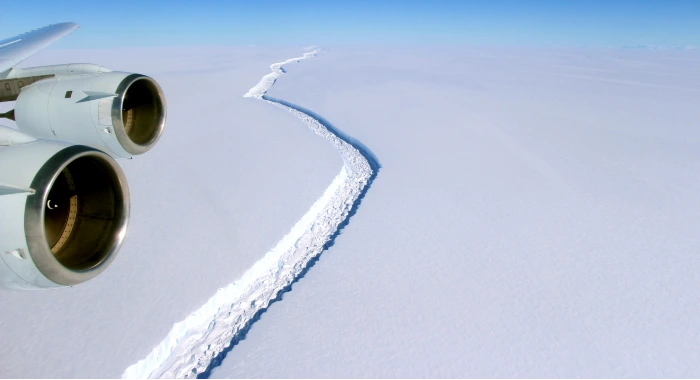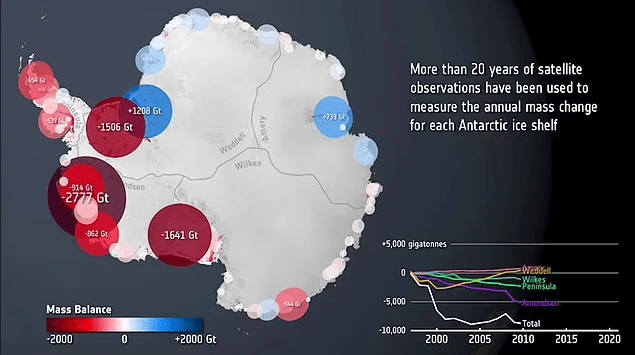Trillions of tons of ice lost.
Across the chilly expanses of Antarctica, something incredible (and terrifying) is happening. Massive shelves of ice are melting, transforming our oceans and the world as we know it.
Antarctica, often perceived as a distant and frozen expanse, has been undergoing significant changes that have alarmed scientists worldwide.
Recent research reveals that an astounding number of its protective ice shelves have suffered dramatic losses over the past few decades.

From 1997 to 2021, out of Antarctica’s 162 ice shelves, a worrying 68 displayed considerable shrinkage.
To paint an even grimmer picture, 28 of these ice shelves lost over half of their ice within this period. On the flip side, while 29 ice shelves grew, 62 remained unchanged, and three demonstrated ambiguous trends in their mass loss, making it difficult to pinpoint any significant patterns.
What does the melting of these ice shelves mean for the global ecosystem? Primarily, the melted ice, which usually serves as a protective barrier for the larger glaciers, subsequently flows into our oceans.
The resulting effect is a rising concern for scientists: potentially catastrophic sea level rises over the coming decades and centuries due to the accelerated melting from both Antarctica and Greenland.

Ted Scambos, an ice scientist from the University of Colorado, underscores the significance of these findings, stating, “Determining precisely how and the extent to which ice is depleting from these safeguarding floating shelves is crucial to comprehending the evolution of Antarctica.”
He also pointed out that this melt introduces freshwater into the Amundsen Sea, a crucial area for potential sea level rise. This influx not only contributes to rising sea levels but also impacts the sea’s density and salinity.
One of the most alarming events, Scambos mentions, was the dislodging of colossal icebergs in the years 1999, 2000, and 2002, each comparable to the size of Delaware.
Moreover, the study brings attention to the melting induced by warmer waters beneath the ice shelves.

Benjamin Davison, the study’s primary author, emphasizes the role of ice shelves as the guardians of the Antarctic environment, holding back massive glaciers and preventing them from rushing into the oceans. He noted, “The real narrative isn’t just the vast amounts of ice loss, but rather the patterns of individual shelf deterioration.”

To provide a perspective on the scale of this melting, the study estimates a loss of approximately 8.3 trillion tons of ice over the past 25 years. Within this framework, certain glaciers, such as Wordie, have faced such drastic depletion that they are on the brink of vanishing. Others, like the Thwaites ice shelf—often referred to as the ‘Doomsday’ glacier due to its rapid melting rate—have shed 70% of their mass since 1997.
It’s worth noting that while some ice shelves on the eastern side of the continent experienced growth, they did so at a rate slower than their counterparts losing ice in the west.
Davison explained that while it’s challenging to directly tie an individual ice shelf’s deterioration to human-induced climate change, a consistent decline is anticipated in our warming world.
More To Discover
- The Sweet Smell of Pest Control: Roses to the Rescue in Organic Farming
- World’s Tiniest Marine Mammal Faces Imminent Extinction In First Alert Issued By International Whaling Commission
- The U.S. Forest Service’s Controversial Plan to Store Carbon Dioxide Under National Forests
- Swedish Technique Produces Hydrogen Energy That’s Safe, Efficient, and Metal-Free
In essence, the rapid degradation of Antarctica’s ice shelves serves as a stark reminder of the interconnectedness of our planet’s ecosystems and the potential global consequences of regional environmental shifts.
Source: Science Advances




















